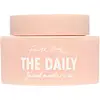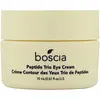What's inside
What's inside
 Key Ingredients
Key Ingredients

 Benefits
Benefits

 Concerns
Concerns

 Ingredients Side-by-side
Ingredients Side-by-side

Water
Skin ConditioningCaprylic/Capric Triglyceride
MaskingSqualane
EmollientGlycerin
HumectantC15-19 Alkane
SolventCetyl Alcohol
EmollientCetearyl Alcohol
EmollientGlyceryl Stearate Citrate
EmollientCetearyl Olivate
C13-14 Alkane
SolventLitchi Chinensis Fruit Extract
Skin ConditioningSodium Hyaluronate
HumectantTocopherol
AntioxidantPanthenol
Skin ConditioningHydrolyzed Jojoba Esters
Skin ConditioningGlycine Soja Sterols
EmollientCamellia Sinensis Leaf Extract
AntimicrobialPyrus Malus Fruit Extract
Skin ConditioningAvena Sativa Bran Extract
AbrasiveCalendula Officinalis Flower Extract
MaskingAllantoin
Skin ConditioningLinoleic Acid
CleansingPhospholipids
Skin ConditioningSodium PCA
HumectantPlankton Extract
Skin ConditioningLaminaria Saccharina Extract
Skin ProtectingPseudoalteromonas Exopolysaccharides
Skin ConditioningCucumis Melo Fruit Extract
Skin ConditioningMangifera Indica Fruit Extract
Skin ConditioningCitrullus Lanatus Fruit Extract
Skin ConditioningPunica Granatum Fruit Extract
AntioxidantMalus Sylvestris Flower Extract
AntioxidantLens Esculenta Fruit Extract
Skin ConditioningPrunus Amygdalus Dulcis Fruit Extract
Skin ConditioningJasminum Officinale Flower/Leaf Extract
MaskingCananga Odorata Flower Extract
PerfumingVanilla Planifolia Fruit Extract
Skin ConditioningCitrus Clementina Fruit Extract
Skin ConditioningCitrus Tangerina Peel Extract
AstringentCitrus Aurantium Dulcis Peel Extract
Emulsion StabilisingCitrus Paradisi Fruit Extract
Skin ConditioningCitrus Grandis Peel Extract
AstringentCitrus Limon Peel Extract
EmollientCitrus Aurantifolia Peel Extract
CleansingMentha Viridis Extract
MaskingQuartz
AbrasiveSodium Salicylate
PreservativeSodium Lactate
BufferingGlyceryl Caprylate
EmollientSorbitan Olivate
EmulsifyingMaltodextrin
AbsorbentGlycol Distearate
EmollientCarbomer
Emulsion StabilisingButylene Glycol
HumectantCitric Acid
BufferingCaprylyl Glycol
EmollientHexylene Glycol
EmulsifyingPotassium Sorbate
PreservativeWater, Caprylic/Capric Triglyceride, Squalane, Glycerin, C15-19 Alkane, Cetyl Alcohol, Cetearyl Alcohol, Glyceryl Stearate Citrate, Cetearyl Olivate, C13-14 Alkane, Litchi Chinensis Fruit Extract, Sodium Hyaluronate, Tocopherol, Panthenol, Hydrolyzed Jojoba Esters, Glycine Soja Sterols, Camellia Sinensis Leaf Extract, Pyrus Malus Fruit Extract, Avena Sativa Bran Extract, Calendula Officinalis Flower Extract, Allantoin, Linoleic Acid, Phospholipids, Sodium PCA, Plankton Extract, Laminaria Saccharina Extract, Pseudoalteromonas Exopolysaccharides, Cucumis Melo Fruit Extract, Mangifera Indica Fruit Extract, Citrullus Lanatus Fruit Extract, Punica Granatum Fruit Extract, Malus Sylvestris Flower Extract, Lens Esculenta Fruit Extract, Prunus Amygdalus Dulcis Fruit Extract, Jasminum Officinale Flower/Leaf Extract, Cananga Odorata Flower Extract, Vanilla Planifolia Fruit Extract, Citrus Clementina Fruit Extract, Citrus Tangerina Peel Extract, Citrus Aurantium Dulcis Peel Extract, Citrus Paradisi Fruit Extract, Citrus Grandis Peel Extract, Citrus Limon Peel Extract, Citrus Aurantifolia Peel Extract, Mentha Viridis Extract, Quartz, Sodium Salicylate, Sodium Lactate, Glyceryl Caprylate, Sorbitan Olivate, Maltodextrin, Glycol Distearate, Carbomer, Butylene Glycol, Citric Acid, Caprylyl Glycol, Hexylene Glycol, Potassium Sorbate
Water
Skin ConditioningDiisopropyl Dimer Dilinoleate
EmollientGlycerin
HumectantGlyceryl Stearate
EmollientPolyglyceryl-2 Diisostearate
EmulsifyingButyrospermum Parkii Butter
Skin ConditioningSqualane
EmollientHydrogenated Polydecene
EmollientCetyl Alcohol
EmollientPolyglyceryl-6 Palmitate/Succinate
EmulsifyingC12-15 Alkyl Benzoate
AntimicrobialPalmitoyl Hexapeptide-12
Skin ConditioningPalmitoyl Tripeptide-1
Skin ConditioningPalmitoyl Tetrapeptide-7
Skin ConditioningGinkgo Biloba Leaf Extract
Skin ConditioningCamellia Sinensis Leaf Extract
AntimicrobialSodium Hyaluronate
HumectantPrunus Amygdalus Dulcis Oil
Skin ConditioningPersea Gratissima Oil
Skin ConditioningSesamum Indicum Seed Oil
EmollientPanax Ginseng Root Extract
EmollientSimmondsia Chinensis Seed Extract
AbrasiveEpilobium Angustifolium Flower/Leaf/Stem Extract
Skin ConditioningCeramide Ng
Skin ConditioningTribehenin
EmollientAmmonium Acryloyldimethyltaurate/Vp Copolymer
1,2-Hexanediol
Skin ConditioningCaprylyl Glycol
EmollientHydroxyacetophenone
AntioxidantButylene Glycol
HumectantOzokerite
Emulsion StabilisingCarbomer
Emulsion StabilisingXanthan Gum
EmulsifyingSodium Hydroxide
BufferingCetearyl Alcohol
EmollientPolysorbate 20
EmulsifyingWater, Diisopropyl Dimer Dilinoleate, Glycerin, Glyceryl Stearate, Polyglyceryl-2 Diisostearate, Butyrospermum Parkii Butter, Squalane, Hydrogenated Polydecene, Cetyl Alcohol, Polyglyceryl-6 Palmitate/Succinate, C12-15 Alkyl Benzoate, Palmitoyl Hexapeptide-12, Palmitoyl Tripeptide-1, Palmitoyl Tetrapeptide-7, Ginkgo Biloba Leaf Extract, Camellia Sinensis Leaf Extract, Sodium Hyaluronate, Prunus Amygdalus Dulcis Oil, Persea Gratissima Oil, Sesamum Indicum Seed Oil, Panax Ginseng Root Extract, Simmondsia Chinensis Seed Extract, Epilobium Angustifolium Flower/Leaf/Stem Extract, Ceramide Ng, Tribehenin, Ammonium Acryloyldimethyltaurate/Vp Copolymer, 1,2-Hexanediol, Caprylyl Glycol, Hydroxyacetophenone, Butylene Glycol, Ozokerite, Carbomer, Xanthan Gum, Sodium Hydroxide, Cetearyl Alcohol, Polysorbate 20
Ingredients Explained
These ingredients are found in both products.
Ingredients higher up in an ingredient list are typically present in a larger amount.
Butylene Glycol (or BG) is used within cosmetic products for a few different reasons:
Overall, Butylene Glycol is a safe and well-rounded ingredient that works well with other ingredients.
Though this ingredient works well with most skin types, some people with sensitive skin may experience a reaction such as allergic rashes, closed comedones, or itchiness.
Learn more about Butylene GlycolCamellia Sinensis Leaf Extract is derived from the leaves of the tea plant. Black tea, green tea, and oolong tea are all harvested from this plant.
This ingredient has many skin benefits:
This ingredient contains polyphenols, a strong antioxidant. Antioxidants help fight off molecules that damage skin cells.
On top of that, the antioxidants in green tea neutralize free-radicals from the sun. This gives the skin some extra UV protection, but should not replace sunscreen.
Many components of tea have anti-inflammatory properties.
Polyphenols and L-theanine help soothe the skin and reduce irritation. The caffeine in Camellia Sinensis Leaf Extract helps calm inflamed blood vessels.
Other compounds found in tea include: Vitamin Bs, linoleic acid, magnesium, calcium, iron, and zinc.
Research has shown both drinking Camellia Sinensis Leaf Tea and applying it to the skin can help boost skin elasticity and hydration. Studies also show using tea extract may reduce sebum, or oil, production.
Learn more about Camellia Sinensis Leaf ExtractCaprylyl Glycol is a humectant and emollient, meaning it attracts and preserves moisture.
It is a common ingredient in many products, especially those designed to hydrate skin. The primary benefits are retaining moisture, skin softening, and promoting a healthy skin barrier.
Though Caprylyl Glycol is an alcohol derived from fatty acids, it is not the kind that can dry out skin.
This ingredient is also used as a preservative to extend the life of products. It has slight antimicrobial properties.
Learn more about Caprylyl GlycolCarbomer is a polymer of acrylic acid. Its main role is to create a gel consistency.
A high amount of carbomer can cause pilling or balling up of products. Don't worry, most products contain 1% or less of carbomer.
Cetearyl alcohol is a mixture of two fatty alcohols: cetyl alcohol and stearyl alcohol. It is mainly used as an emulsifier. Emulsifiers help prevent the separation of oils and products. Due to its composition, it can also be used to thicken a product or help create foam.
Cetearyl alcohol is an emollient. Emollients help soothe and hydrate the skin by trapping moisture.
Studies show Cetearyl alcohol is non-toxic and non-irritating. The FDA allows products labeled "alcohol-free" to have fatty alcohols.
This ingredient is usually derived from plant oils such as palm, vegetable, or coconut oils. There is debate on whether this ingredient will cause acne.
Due to the fatty acid base, this ingredient may not be Malassezia folliculitis safe.
Learn more about Cetearyl AlcoholCetyl Alcohol is a fatty alcohol. Fatty Alcohols are most often used as an emollient or to thicken a product.
Its main roles are:
Though it has "alcohol" in the name, it is not related to denatured alcohol or ethyl alcohol.
The FDA allows products labeled "alcohol-free" to have fatty alcohols.
Learn more about Cetyl AlcoholGlycerin is already naturally found in your skin. It helps moisturize and protect your skin.
A study from 2016 found glycerin to be more effective as a humectant than AHAs and hyaluronic acid.
As a humectant, it helps the skin stay hydrated by pulling moisture to your skin. The low molecular weight of glycerin allows it to pull moisture into the deeper layers of your skin.
Hydrated skin improves your skin barrier; Your skin barrier helps protect against irritants and bacteria.
Glycerin has also been found to have antimicrobial and antiviral properties. Due to these properties, glycerin is often used in wound and burn treatments.
In cosmetics, glycerin is usually derived from plants such as soybean or palm. However, it can also be sourced from animals, such as tallow or animal fat.
This ingredient is organic, colorless, odorless, and non-toxic.
Glycerin is the name for this ingredient in American English. British English uses Glycerol/Glycerine.
Learn more about GlycerinSodium Hyaluronate is hyaluronic acid's salt form. It is commonly derived from the sodium salt of hyaluronic acid.
Like hyaluronic acid, it is great at holding water and acts as a humectant. This makes it a great skin hydrating ingredient.
Sodium Hyaluronate is naturally occurring in our bodies and is mostly found in eye fluid and joints.
These are some other common types of Hyaluronic Acid:
Learn more about Sodium HyaluronateSqualane is an emollient that helps the skin hold onto moisture. It's an oily liquid that occurs naturally in certain types of fish and plant oils.
Because squalane boosts hydration in the skin, it also comes with plenty of benefits: it is an antioxidant and can help fight free radicals and skin damage. Squalane is also found to have a detoxifying effect when applied.
Squalane comes from squalene, which occurs naturally within the sebum of our skin. It is one of the oils our skin produces to keep itself hydrated. Squalane is the hydrogenated version of squalene and has a longer shelf life.
Research shows that squalane is non-irritating (even at 100% concentration).
In general, it's a fantastic ingredient. It does a great job at hydrating the skin, and it's suitable for those with sensitive skin.
The source of squalane may impact malassezia / fungal acne. This is because olive oil derived squalane can contain impurities such as fatty acids and plant waxes. Sugarcane derived squalane is recommended for anyone with malassezia concerns.
Is squalane vegan?
This depends on the source. Squalane can be derived from both plants and animals. Most squalane used in skincare comes from plants.
Please note: the source of squalane is only known if disclosed by the brand. We recommend reaching out to the brand if you have any questions about their squalane.
Read more about squalene with an "e".
Is squalane an oil?
Squalane is often called an oil, but it’s technically not; it’s a hydrocarbon, meaning it’s only made of carbon and hydrogen, unlike true oils which are triglycerides made of fatty acids and glycerol.
The term “oil-free” isn’t regulated, so companies can define it however they want. Some exclude all oils, while others just avoid mineral oil or comedogenic oils.
While some people avoid oils thinking they cause breakouts, the right kind of oil (or oil-like ingredient like squalane) can actually help balance and hydrate your skin. It’s worth testing out simple oils or squalane to see what works best for your skin.
Learn more about SqualaneWater. It's the most common cosmetic ingredient of all. You'll usually see it at the top of ingredient lists, meaning that it makes up the largest part of the product.
So why is it so popular? Water most often acts as a solvent - this means that it helps dissolve other ingredients into the formulation.
You'll also recognize water as that liquid we all need to stay alive. If you see this, drink a glass of water. Stay hydrated!
Learn more about Water